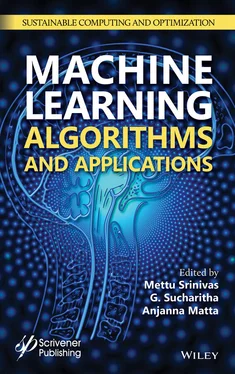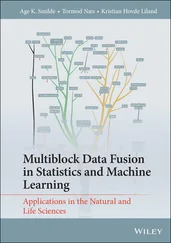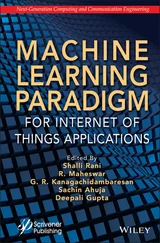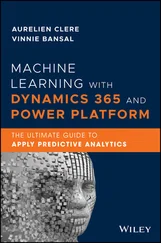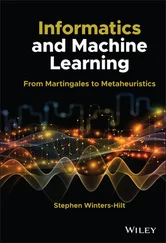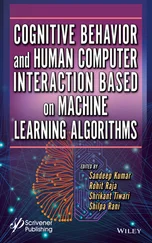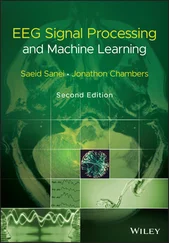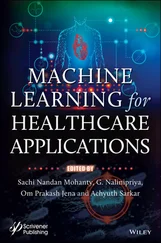Machine Learning Algorithms and Applications
Здесь есть возможность читать онлайн «Machine Learning Algorithms and Applications» — ознакомительный отрывок электронной книги совершенно бесплатно, а после прочтения отрывка купить полную версию. В некоторых случаях можно слушать аудио, скачать через торрент в формате fb2 и присутствует краткое содержание. Жанр: unrecognised, на английском языке. Описание произведения, (предисловие) а так же отзывы посетителей доступны на портале библиотеки ЛибКат.
- Название:Machine Learning Algorithms and Applications
- Автор:
- Жанр:
- Год:неизвестен
- ISBN:нет данных
- Рейтинг книги:4 / 5. Голосов: 1
-
Избранное:Добавить в избранное
- Отзывы:
-
Ваша оценка:
- 80
- 1
- 2
- 3
- 4
- 5
Machine Learning Algorithms and Applications: краткое содержание, описание и аннотация
Предлагаем к чтению аннотацию, описание, краткое содержание или предисловие (зависит от того, что написал сам автор книги «Machine Learning Algorithms and Applications»). Если вы не нашли необходимую информацию о книге — напишите в комментариях, мы постараемся отыскать её.
Machine Learning Algorithms and Applications — читать онлайн ознакомительный отрывок
Ниже представлен текст книги, разбитый по страницам. Система сохранения места последней прочитанной страницы, позволяет с удобством читать онлайн бесплатно книгу «Machine Learning Algorithms and Applications», без необходимости каждый раз заново искать на чём Вы остановились. Поставьте закладку, и сможете в любой момент перейти на страницу, на которой закончили чтение.
Интервал:
Закладка:
9 Part 4: Machine Learning for Classification and Information Retrieval Systems 14 AnimNet: An Animal Classification Network using Deep Learning 14.1 Introduction 14.2 Related Work 14.3 Proposed Methodology 14.4 Results 14.5 Conclusion References 15 A Hybrid Approach for Feature Extraction From Reviews to Perform Sentiment Analysis 15.1 Introduction 15.2 Related Work 15.3 The Proposed System 15.4 Result Analysis 15.5 Conclusion References 16 Spark-Enhanced Deep Neural Network Framework for Medical Phrase Embedding 16.1 Introduction 16.2 Related Work 16.3 Proposed Approach 16.4 Experimental Setup 16.5 Results 16.6 Conclusion References 17 Image Anonymization Using Deep Convolutional Generative Adversarial Network 17.1 Introduction 17.2 Background Information 17.3 Image Anonymization to Prevent Model Inversion Attack 17.4 Results and Analysis 17.5 Conclusion References
10 Index
11 End User License Agreement
List of Illustrations
1 Chapter 1 Figure 1.1 Workflow of the application. Figure 1.2 Basic steps of recurrent neural network. Figure 1.3 Screenshot of fetched data. Figure 1.4 Predicted values in Bengaluru in December, 2017. Figure 1.5 Predicted values in Bengaluru in June, 2020. Figure 1.6 Predicted values in New Delhi in December, 2017. Figure 1.7 Predicted values in New Delhi in June, 2020. Figure 1.8 Heat map for ozone O 3for day and night in December, 2017. Figure 1.9 Heat map for ozone O 3for day and night in June, 2020. Figure 1.10 Heat map for all parameters for 3 days and nights in December, 2017. Figure 1.11 Heat map for all parameters for 3 days and nights in June, 2020. Figure 1.12 Predicted values for O 3for Anand Vihar, New Delhi. Figure 1.13 Predicted values for PM 10for Sector 62, Noida. Figure 1.14 Pollution levels in major Indian cities.
2 Chapter 2 Figure 2.1 Adding a key marker on the silkworm egg sheet. Figure 2.2 Silkworm egg classes: hatched eggs and unhatched eggs. Figure 2.3 Core CNN model. Figure 2.4 Foreground-background segmentation of entire silkworm egg sheet (a) (input) and (b) (output). Figure 2.5 CNN training model to predict egg location in terms of pixel values. Figure 2.6 Result of egg location CNN model. Figure 2.7 Result of egg classification generated by the proposed method.
3 Chapter 3 Figure 3.1 Deep Neural Network architecture. Figure 3.2 Framework of the proposed methodology. Figure 3.3 Distribution of average wind speed: (a) distribution chart and (b) histogram. Figure 3.4 The architecture of the proposed DNN model.Figure 3.5 Prediction accuracy based on (a) RMSE, (b) MAE, and (c) R 2.Figure 3.6 Comparison of predicted against the actual values...Figure 3.7 Comparison of prediction accuracy of DNN and other models...
4 Chapter 4Figure 4.1 ResNet module (adapted from....Figure 4.2 Bridge connection in ResNet (adapted from....Figure 4.3 Squeeze-and-Excitation block (adapted from....Figure 4.4 Modified bridge...Figure 4.5 (a) Training losses plotted for depth of 20 layers. (b) Training losses plotted for depth of 32 layers.Figure 4.6 (a) Training losses plotted for depth of 44 layers. (b) Training losses plotted for depth of 56 layers.Figure 4.7 Training losses plotted for depth of 110 layers.
5 Chapter 5Figure 5.1 Uncovering the network layers for final computation.Figure 5.2 Terms attach with DS.Figure 5.3 ANN serves as a base for DL.Figure 5.4 Flow for pre-trained network-based learning model....Figure 5.5 Typical CNN process...Figure 5.6 Primitive RNN architecture.Figure 5.7 Graph-based representation in recursive NN.Figure 5.8 3 × 3 filter convolve over 6 × 6 image matrix.Figure 5.9 Pooling reduces the size of transition matrix.Figure 5.10 Multi-layer neural network.
6 Chapter 6Figure 6.1 Rise in issuing of credit cards during 2012–2016.Figure 6.2 Proposed two-stage credit scoring model.Figure 6.3 Comparative graph on various credit scoring datasets.
7 Chapter 7Figure 7.1 Proposed framework.Figure 7.2 Plot of histogram comparison for shot boundary detection.Figure 7.3 Key frames extracted by the proposed framework: (a) before post-processing and (b) after post-processing.Figure 7.4 (a) Proposed system summary. (b) VSUMM summary.Figure 7.5 Performance of proposed framework based on (a) average compression ratio and (b) average computation time.Figure 7.6 Comparison of proposed system with existing systems based on quantitative metrics.Figure 7.7 Performance of proposed system based on qualitative measures.
8 Chapter 8Figure 8.1 Workflow diagram describing the approach to ECG classification used in the paper.Figure 8.2 Classification accuracies comparison between XGBoost and AdaBoost classifiers.Figure 8.3 Comparison between proposed work and other existing literature.
9 Chapter 9Figure 9.1 Microarray technology.Figure 9.2 Basic information for gene expression, (a) how gene is expressed, and (b) external effect by gene expression to produced diseases.Figure 9.3 Foundation of GSA in (a) mass attraction, and (b) flowchart of GSA.Figure 9.4 Proposed model.Figure 9.5 Fitness evaluation.Figure 9.6 Fitness vs. iteration for (a) Prostate data, (b) DLBCL data, (c) Gastric cancer data, (d) Lymphoma and leukemia, and (e) Child all data.Figure 9.7 Accuracy vs. Classifier for (a) Prostate data, (b) DLBCL data, (c) Lymphoma and leukemia data, (d) Gastric cancer data, and (e) Child all data.Figure 9.8 Heat map for (a) Child all data, (b) DLBCL data, (c) Prostate data, (d) Gastric cancer data, and (e) Lymphoma and leukemia data.
10 Chapter 10Figure 10.1 Sample images from both the employed databases.Figure 10.2 ROC curves for same-spectral matchings of (top) PolyU and (bottom) Cross-Eyed.Figure 10.3 ROC curves for cross-spectral matchings of (top) PolyU and (bottom) Cross-Eyed.Figure 10.4 Bar charts for EER values after feature-level fusion.
11 Chapter 11Figure 11.1 Dataset description.Figure 11.2 Explained variance ratio of fitted principal components.Figure 11.3 ANN architecture.Figure 11.4 Rectified linear units.Figure 11.5 Sigmoid function.Figure 11.6 Random forest architecture.Figure 11.7 Model accuracy.Figure 11.8 Model loss.Figure 11.9 Accuracy of different models.Figure 11.10 ROC curve XG Boost.Figure 11.11 ROC curve Random Forest.
12 Chapter 12Figure 12.1 Sample images from the NIST DB-4 dataset showing all five classes.Figure 12.2 Results after applying the SURF algorithm...Figure 12.3 Left: Original, raw fingerprint image. Right: Normalized image.Figure 12.4 Left: Original, raw fingerprint image. Right: Estimated local orientation.Figure 12.5 Left: Tented Arch fingerprint. Right: Whorl fingerprint...Figure 12.6 Confusion matrix. The diagonal elements show the number of correctly predicted fingerprints of each class.Figure 12.7 The outputs of the 1st to 5th convolutional layers...Figure 12.8 (a–c) The raw fingerprint image from the tented arch class...
13 Chapter 13Figure 13.1 Seven basic emotional expressions...Figure 13.2 Pipeline approach on automatic and handcraft method.Figure 13.3 Gradient computation depending on kernel.Figure 13.4 SVM classifier for two features.
14 Chapter 14Figure 14.1 Artificial neural network.Figure 14.2 Layers of VGG16 and VGG19 network.Figure 14.3 The architecture of convolution neural network.Figure 14.4 Plots of Xception network. (a) Training loss of Xception network (b) accuracy of Xception network.Figure 14.5 Plots of AnimNet network. (a) Training loss of AnimNet network (b) accuracy of AnimNet networks.Figure 14.6 Accuracy of class “dog” (size of image = 200*200 pixels). (a) Using Xception network (b) using AnimNet network.Figure 14.7 Accuracy of class “cat” (size of image = 200*200 pixels). (a) Using Xception network (b) using AnimNet network.Figure 14.8 Accuracy of class “cow” (size of image = 200*200 pixels). (a) Using Xception network (b) using AnimNet network.Figure 14.9 Accuracy of class “horse” (size of image = 200*200 pixels). (a) Using Xception network (b) using AnimNet network.Figure 14.10 Accuracy of class “goat” (size of image = 200*200 pixels). (a) Using Xception network (b) using AnimNet network.Figure 14.11 Accuracy of class “monkey” (size of image = 200*200 pixels). (a) Using Xception network (b) using AnimNet network.
Читать дальшеИнтервал:
Закладка:
Похожие книги на «Machine Learning Algorithms and Applications»
Представляем Вашему вниманию похожие книги на «Machine Learning Algorithms and Applications» списком для выбора. Мы отобрали схожую по названию и смыслу литературу в надежде предоставить читателям больше вариантов отыскать новые, интересные, ещё непрочитанные произведения.
Обсуждение, отзывы о книге «Machine Learning Algorithms and Applications» и просто собственные мнения читателей. Оставьте ваши комментарии, напишите, что Вы думаете о произведении, его смысле или главных героях. Укажите что конкретно понравилось, а что нет, и почему Вы так считаете.
